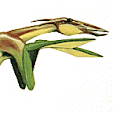This will be another fairly short post. In the previous post I explained that I was working on pages for The Book that explained some biomechanical tricks of Furahan lifeforms. Other such explanatory pages deal with things such as rusp snouts and gaits (done), photosynthetic spectra (done), cloakfish movements (to be done) and spidrid gaits (done).
I will not show the actual spidrid illustrations, but can show you some of the underlying thoughts by way of animations. I used the programs -all Matlab- to produce such animations to choose a single frame, which I then rotated this way and that until I was pleased with the composition. The resulting image was then imported into Corel Painter and used as the guideline for a digital painting. But I will not show these here.
The first animation shows your typical run of the mill garden-variety spidrid. It is walking slowly, meaning that each leg is on the ground for one half of the walking cycle. With eight legs, it is easy to have enough legs on the ground to provide a stable support platform at all times. The ‘support diagram’ is a polygon connecting all feet that are on the ground at any one time.
The gait used here is what I call an ‘alternating ripple’. Imagine that the legs are numbered 1 to 8, going round the animal. If the phase differences are 1/8, 2/8, 3/8, up to 8/8 in the same leg order, then legs that are close in phase would also be close in space, so many legs on one side of the beast could be off the ground at the same time, so it would tipple over. So, we introduce an additional offset for even-numbered legs: 1/8, 5/8, 2/8, 6/8, 3/8, 7/8, 4/8 and 8/8. You will probably need some graph paper to get to grips with all this...
The red lines show the path a legs traces in 3D space. Because the ‘camera’ follows the body, the tracer paths are also respective to the body. The effect is like that of the animal walking along on a treadmill.
The second one is very similar, but the main difference is that the legs are on the ground for less than half the time. Such schemes are typical for fast movements. The animation runs at the same number of frames per second, so you cannot appreciate the speed difference. There are fewer legs on the ground at one time. The polygons of the support diagrams have now morphed into lines or even points, if there is only one leg on the ground.
Now we move to a more specialised racing spidrid. The camera no longer moves along with the beastie, but is fixed in space. The animal has relatively long legs, and runs the risk of knocking them into one another. That has to be avoided by reducing stride length a bit and adapting the gait: adjacent legs should not be at opposite phases in the cycle, as they then will certainly knock into one another. This one is using the ‘slow’ leg pattern at which a foot is one the ground half the time.
This is the same racing spidrid at high speed. Each leg is now on the ground for less than half the time, more suited to fast movements. The animal changed its gait in two ways: the first is that the phase differences between legs are smaller, and arranged in such a way that at times there is no leg on the ground at all. It is effectively jumping! The second change is that the leading leg could only contribute to forwards movement by powerful and fast flexion movement, and I decided that the flexion muscles are relatively weak, so the animal simply lifts that legs into the air. (It should really move the body up and down as well, but the animation was not designed for complete realism.)
Many of the principles here are quite common for earth animals: walking faster is often achieved by increasing cycle frequency, stride length, reducing the fraction of the cycle that a leg is on the ground and adapting gaits to achieve jumps. Most mammals and reptiles always use all four legs at all speeds, with a few exceptions (kangaroos, probably hadrosaurs; no doubt there are more). But these poor unfortunate creatures have to make do with only four legs anyway, leaving them little choice. Earth crabs do have choices, and when they speed up, they actually use fewer legs, down to just two. Spidrids, not to be outdone by Earth creatures, have similar tricks up their virtual sleeves.
